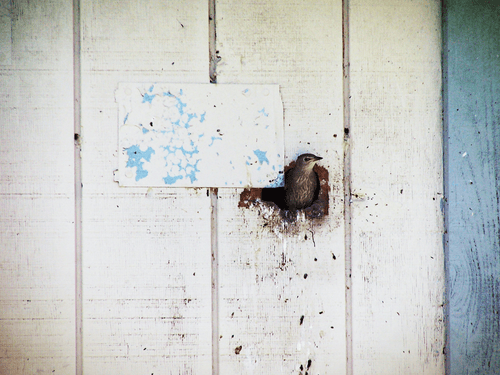How to Stop Birds from Making Holes in House Before They Ruin Your Walls and Rack Up Repairs Understand that If you’ve noticed tiny holes in your cladding, soffits, or vents, birds might be the cause. They often peck or drill at surfaces to check for nesting spots, which can lead to drafts, pests, or even structural damage. Bird damage isn’t just annoying, it can lead to water leaks, higher energy bills, and even pest infestations. Here’s how to stop the pecking before it becomes a full repair job.
Why Birds Peck Holes in Homes
Birds look for safe, hidden places to nest. That includes:
- Wooden cladding
- Soffit boards
- Vent covers
- Attic vents
- Gaps under roof tiles
They may be testing for cavities or starting to build a nest. Catching this early helps prevent bigger problems. Common culprits include woodpeckers, starlings, sparrows, and house finches. Each one has different habits but shares the same goal: safe nesting. They may be testing for cavities or starting to build a nest. Catching this early helps prevent bigger problems. Common culprits include woodpeckers, starlings, sparrows, and house finches. Each one has different habits but shares the same goal: safe nesting.

Step 1: Inspect the Damage
Walk around your home and check for:
- Small holes (1–3 cm wide)
- Peck marks near vents, roof edges, or attic areas
- Feathers, sawdust, or wood chips nearby
Do this early morning or late afternoon when birds are more active. Take photos and note all problem areas. Also listen for rapid tapping or pecking sounds, especially in the morning. A sudden increase in bird calls near your roofline can also be a giveaway. And if insects appear inside suddenly, birds may have opened a hidden entry point.
Step 2: Patch and Seal the Holes
Plug existing holes with wood putty or appropriate fillers to prevent access and discourage further pecking. Always check for trapped birds before sealing. Use the right materials to block entry points:
- Exterior wood filler for small damaged spots
- Stainless steel mesh behind soffits or vents
- Galvanized flashing for soft wood zones
- Fine-mesh vent covers to stop pecking and nesting
Let filler dry, sand smooth, and paint to match. Seal any gaps you missed earlier. Avoid stuffing holes with plastic bags, foam, or fabric. These can trap moisture, attract insects, and may not withstand pecking. Plug holes with wood filler or mesh. For more on how birds exploit garage or attic entries, see How to Get Birds Out of My Garage..
Step 3: Add Physical Barriers
Prevent birds from starting the problem again:
- Fine metal mesh over soffits, vents, and attic openings
- Bird spikes on narrow ledges
- Wire cages or cones over exposed pipes or ducts
These don’t hurt birds. They just make it harder for them to land or nest.
Step 4: Use Visual and Noise Deterrents
Scare birds away from the area with harmless tricks:
- Reflective tape, old CDs, or foil strips
- Fake owls or hawks—move them around often
- Wind chimes for gentle noise near walls
- Ultrasonic sound devices (work best with other methods)
Change their position regularly so birds don’t get used to them. Fake predators and sound deterrents can help. Learn more in How to Scare Away a Bird .
Step 5: Offer Birds a Better Spot
Install nest boxes or birdhouses away from your home. This gives birds a safer alternative and may stop them from drilling into your siding or roof. Mount birdhouses 10–30 feet from your home, ideally on poles or trees. Clean them each year in late winter and choose box sizes suited to birds in your region.
Step 6: Keep the Exterior in Good Shape
A clean, sturdy home is less inviting to birds:
- Inspect after storms
- Repaint peeling areas yearly
- Clear debris and leaves near vents
- Trim trees and shrubs touching your house
- Clean out gutters and soffits regularly
Step 7: Check Wildlife Rules First
If birds have already started nesting:
- Many countries protect active nests with eggs or chicks
- Wait until the nest is abandoned (usually in fall or winter)
- Contact local wildlife services if unsure or dealing with a protected species
If unsure, contact local wildlife departments or pest professionals. They can advise on laws and help with safe exclusion techniques.
Extra Tips That Work
- Bird netting: Hang it 2–3 inches away from siding to stop access
- Reflective deterrents: Pinwheels, scare tape, or shiny balloons can help
- Predator decoys: Rotate plastic owls or snakes so birds don’t adapt
- Cover problem spots: Use burlap while you make permanent repairs
- Avoid sticky repellents: These can harm or kill birds and other wildlife
- Eliminate insects: Woodpeckers may peck for bugs inside wood
FAQ
Ans: Yes. If they can’t find an opening, they usually leave.
Ans: Yes. They’re not sharp and only prevent landing or nesting.
Ans: No. Combine them with other methods for best results.
Ans: Only if they’re inactive. Active nests are protected.
Ans: Late autumn or winter, when birds are less active and fewer laws apply.
Final Thoughts
You can protect your home from bird damage with a mix of good repairs, solid barriers, smart deterrents, and regular upkeep. You don’t need to harm the birds, just make it harder for them to nest where they shouldn’t.
Need help picking the right mesh, vent covers, or decoys? For professional bird-proofing and humane removal, check out Critter Control. They offer licensed and eco-friendly solutions across North America.
